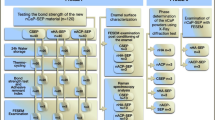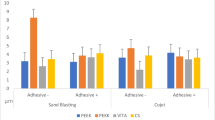Abstract
Objectives
This study aims to evaluate the effect of non-thermal plasma (NTP) surface treatment in two composite inorganic fillers and evaluate their impact on the chemical-mechanical properties and bond strength ability of experimental resin cements.
Materials and methods
Ytterbium fluoride (YF) and barium silicate glass (BS) were characterized and submitted to different surface treatments: non-thermal plasma (NTP); non-thermal plasma and 3-(trimethoxysilyl) propyl methacrylate silanization; and 3-(trimethoxysilyl) propyl methacrylate silanization. Untreated fillers were used as a control. The fillers were incorporated at 65wt% concentration into light-cured experimental resin cements (50wt% BisGMA; 25wt% UDMA; 25wt% TEGDMA; 1mol% CQ). The degree of conversion, the flexural strength, and the microshear bond strength (μSBS) were evaluated to characterize developed composites.
Results
YF and BS were successfully cleaned with NTP treatment. Nor NTP neither the silanization affected the degree of conversion of resin cements. The NTP predicted an increase in YF-containing resin cements flexural strength, reducing the storage impact in these materials. NTP treatment did not affect the μSBS when applied to YF, while silanization was effective for BS-containing materials.
Conclusion
NTP treatment of inorganic particles was possible and was shown to reduce the amount of organic contamination of the particle surface. YF surface treatment with NTP can be an alternative to improve the organic/inorganic interaction in resin composites to obtain materials with better mechanical properties.
Clinical relevance
Surface cleaning with NTP may be an alternative for particle surface cleaning to enhance organic-inorganic interaction in dental composites resulting in improved mechanical strength of experimental resin cements.



Similar content being viewed by others
References
Rizzante FAP, Locatelli PM, Porto TS et al (2018) Physico-mechanical properties of resin cement light cured through different ceramic spacers. J Mech Behav Biomed Mater 85:170–174. https://doi.org/10.1016/j.jmbbm.2018.06.001
da Silva EM, Noronha-Filho JD, Amaral CM et al (2013) Long-term degradation of resin-based cements in substances present in the oral environment: influence of activation mode. J Appl Oral Sci 21:271–277. https://doi.org/10.1590/1679-775720130026
Aydınoğlu A, Yoruç ABH (2017) Effects of silane-modified fillers on properties of dental composite resin. Mater Sci Eng C Mater Biol Appl 79:382–389. https://doi.org/10.1016/j.msec.2017.04.151
Cavalcante LM, Ferraz LG, Antunes KB et al (2021) Silane content influences physicochemical properties in nanostructured model composites. Dent Mater Off Publ Acad Dent Mater 37:e85–e93. https://doi.org/10.1016/j.dental.2020.10.022
Lung CYK, Sarfraz Z, Habib A et al (2016) Effect of silanization of hydroxyapatite fillers on physical and mechanical properties of a bis-GMA based resin composite. J Mech Behav Biomed Mater 54:283–294. https://doi.org/10.1016/j.jmbbm.2015.09.033
Matinlinna JP, Lung CYK, Tsoi JKH (2018) Silane adhesion mechanism in dental applications and surface treatments: a review. Dent Mater 34:13–28. https://doi.org/10.1016/j.dental.2017.09.002
Sideridou ID, Karabela MM (2009) Effect of the amount of 3-methacyloxypropyltrimethoxysilane coupling agent on physical properties of dental resin nanocomposites. Dent Mater Off Publ Acad Dent Mater 25:1315–1324. https://doi.org/10.1016/j.dental.2009.03.016
Ferracane JL (2011) Resin composite--state of the art. Dent Mater Off Publ Acad Dent Mater 27:29–38. https://doi.org/10.1016/j.dental.2010.10.020
Yang J, Liao M, Hong G et al (2020) Effect of APTES- or MPTS-conditioned nanozirconia fillers on mechanical properties of Bis-GMA-based resin composites. ACS Omega 5:32540–32550. https://doi.org/10.1021/acsomega.0c04762
Cho K, Wang G, Raju R et al (2019) Influence of surface treatment on the interfacial and mechanical properties of short S-glass fiber-reinforced dental composites. ACS Appl Mater Interfaces 11:32328–32338. https://doi.org/10.1021/acsami.9b01857
Ahangaran F, Navarchian AH (2020) Recent advances in chemical surface modification of metal oxide nanoparticles with silane coupling agents: a review. Adv Colloid Interface Sci 286:102298. https://doi.org/10.1016/j.cis.2020.102298
Moreau M, Orange N, Feuilloley MGJ (2008) Non-thermal plasma technologies: new tools for bio-decontamination. Biotechnol Adv 26:610–617. https://doi.org/10.1016/j.biotechadv.2008.08.001
Valverde GB, Coelho PG, Janal MN et al (2013) Surface characterisation and bonding of Y-TZP following non-thermal plasma treatment. J Dent 41:51–59. https://doi.org/10.1016/j.jdent.2012.10.002
Zhu X-M, Zhou J-F, Guo H et al (2018) Effects of a modified cold atmospheric plasma jet treatment on resin-dentin bonding. Dent Mater J 37:798–804. https://doi.org/10.4012/dmj.2017-314
Filho AJV, dos Santos DM, Goiato MC et al (2014) Surface characterization of lithium disilicate ceramic after nonthermal plasma treatment. J Prosthet Dent 112:1156–1163. https://doi.org/10.1016/j.prosdent.2014.02.021
Chen M, Zhang Y, Sky Driver M et al (2013) Surface modification of several dental substrates by non-thermal, atmospheric plasma brush. Dent Mater Off Publ Acad Dent Mater 29:871–880. https://doi.org/10.1016/j.dental.2013.05.002
Silva NRFA, Coelho PG, Valverde GB et al (2011) Surface characterization of Ti and Y-TZP following non-thermal plasma exposure. J Biomed Mater Res B Appl Biomater 99:199–206. https://doi.org/10.1002/jbm.b.31887
Habekost LV, Camacho GB, Demarco FF, Powers JM (2007) Tensile bond strength and flexural modulus of resin cements—influence on the fracture resistance of teeth restored with ceramic inlays. Oper Dent 32:488–495. https://doi.org/10.2341/06-140
Solon-de-Mello M, da Silva Fidalgo TK, dos Santos LA et al (2019) Longevity of indirect restorations cemented with self-adhesive resin luting with and without selective enamel etching. A Systematic review and meta-analysis. J Esthet Restor Dent 31:327–337. https://doi.org/10.1111/jerd.12504
Sousa SJL, Poubel DLN, Rezende LVM, et al (2020) Early clinical performance of resin cements in glass-ceramic posterior restorations in adult vital teeth: a systematic review and meta-analysis. J Prosthet Dent 123:61–70. doi: https://doi.org/10.1016/j.prosdent.2018.12.006
Barbon FJ, Moraes RR, Calza JV et al (2018) Inorganic filler content of resin-based luting agents and the color of ceramic veneers. Braz Oral Res 32:e49. https://doi.org/10.1590/1807-3107bor-2018.vol32.0049
Azad E, Atai M, Zandi M et al (2018) Structure–properties relationships in dental adhesives: effect of initiator, matrix monomer structure, and nano-filler incorporation. Dent Mater 34:1263–1270. https://doi.org/10.1016/j.dental.2018.05.013
Habib E, Wang R, Zhu XX (2018) Correlation of resin viscosity and monomer conversion to filler particle size in dental composites. Dent Mater Off Publ Acad Dent Mater 34:1501–1508. https://doi.org/10.1016/j.dental.2018.06.008
Mohamed NI, Safy RK, Elezz AFA (2020) Microtensile bond strength, marginal leakage, and antibacterial effect of bulk fill resin composite with alkaline fillers versus incremental nanohybrid composite resin. Eur J Dent. https://doi.org/10.1055/s-0040-1721310
Collares FM, Ogliari FA, Lima GS et al (2010) Ytterbium trifluoride as a radiopaque agent for dental cements. Int Endod J 43:792–797. https://doi.org/10.1111/j.1365-2591.2010.01746.x
Martins GC, Meier MM, Loguercio AD et al (2014) Effects of adding barium-borosilicate glass to a simplified etch-and-rinse adhesive on radiopacity and selected properties. J Adhes Dent 16:107–114. https://doi.org/10.3290/j.jad.a30687
de Figueiredo EZ, de Souza BG, Castelo Branco Leitune V, Mezzomo Collares F (2020) Niobium silicate as a filler for an experimental photopolymerizable luting agent. J Prosthodont Res. https://doi.org/10.2186/jpr.JPOR_2019_420
Lung CYK, Matinlinna JP (2012) Aspects of silane coupling agents and surface conditioning in dentistry: an overview. Dent Mater Off Publ Acad Dent Mater 28:467–477. https://doi.org/10.1016/j.dental.2012.02.009
Zhang H, Lu X, Leng Y et al (2009) Molecular dynamics simulations on the interaction between polymers and hydroxyapatite with and without coupling agents. Acta Biomater 5:1169–1181. https://doi.org/10.1016/j.actbio.2008.11.014
Musanje L, Ferracane JL, Ferracane LL (2006) Effects of resin formulation and nanofiller surface treatment on in vitro wear of experimental hybrid resin composite. J Biomed Mater Res B Appl Biomater 77:120–125. https://doi.org/10.1002/jbm.b.30400
Costa BC, Guerreiro-Tanomaru JM, Bosso-Martelo R et al (2018) Ytterbium oxide as radiopacifier of calcium silicate-based cements. Physicochemical and Biological Properties. Braz Dent J 29:452–458. https://doi.org/10.1590/0103-6440201802033
ISO 4049:2009 - Dentistry -- Polymer-based restorative materials. https://www.iso.org/standard/42898.html. Accessed 4 Feb 2018
Ikejima I, Nomoto R, McCabe JF (2003) Shear punch strength and flexural strength of model composites with varying filler volume fraction, particle size and silanation. Dent Mater Off Publ Acad Dent Mater 19:206–211. https://doi.org/10.1016/s0109-5641(02)00031-3
Kylián O, Rauscher H, Gilliland D et al (2008) Removal of model proteins by means of low-pressure inductively coupled plasma discharge. J Phys Appl Phys 41:095201. https://doi.org/10.1088/0022-3727/41/9/095201
Charoux CMG, Patange A, Lamba S et al (2021) Applications of nonthermal plasma technology on safety and quality of dried food ingredients. J Appl Microbiol 130:325–340. https://doi.org/10.1111/jam.14823
Starič P, Vogel-Mikuš K, Mozetič M, Junkar I (2020) Effects of nonthermal plasma on morphology, genetics and physiology of seeds: a review. Plants 9:1736. https://doi.org/10.3390/plants9121736
Zanchi CH, Ogliari FA, Marques e Silva R et al (2015) Effect of the silane concentration on the selected properties of an experimental microfilled composite resin. Appl Adhes Sci 3:27. https://doi.org/10.1186/s40563-015-0054-0
Shortall AC, Palin WM, Burtscher P (2008) Refractive index mismatch and monomer reactivity influence composite curing depth. J Dent Res 87:84–88. https://doi.org/10.1177/154405910808700115
Arikawa H, Kanie T, Fujii K et al (2007) Effect of filler properties in composite resins on light transmittance characteristics and color. Dent Mater J 26:38–44
Novais VR, Raposo LHA, de Miranda RR et al (2017) Degree of conversion and bond strength of resin-cements to feldspathic ceramic using different curing modes. J Appl Oral Sci Rev FOB 25:61–68. https://doi.org/10.1590/1678-77572016-0221
Fronza BM, Lewis S, Shah PK et al (2019) Modification of filler surface treatment of composite resins using alternative silanes and functional nanogels. Dent Mater Off Publ Acad Dent Mater 35:928–936. https://doi.org/10.1016/j.dental.2019.03.007
Lee C, Kashima K, Ichikawa A et al (2020) Influence of hydrolysis degradation of silane coupling agents on mechanical performance of CAD/CAM resin composites: in silico multi-scale analysis. Dent Mater J 39:803–807. https://doi.org/10.4012/dmj.2019-223
Provenzi C, Collares FM, Cuppini M et al (2018) Effect of nanostructured zirconium dioxide incorporation in an experimental adhesive resin. Clin Oral Investig 22:2209–2218. https://doi.org/10.1007/s00784-017-2311-z
Braga RR (2018) Calcium phosphates as ion-releasing fillers in restorative resin-based materials. Dent Mater Off Publ Acad Dent Mater. https://doi.org/10.1016/j.dental.2018.08.288
Seifan M, Sarabadani Z, Berenjian A (2020) Microbially induced calcium carbonate precipitation to design a new type of bio self-healing dental composite. Appl Microbiol Biotechnol 104:2029–2037. https://doi.org/10.1007/s00253-019-10345-9
Sun J, Forster AM, Johnson PM et al (2011) Improving performance of dental resins by adding titanium dioxide nanoparticles. Dent Mater Off Publ Acad Dent Mater 27:972–982. https://doi.org/10.1016/j.dental.2011.06.003
Attik N, Hallay F, Bois L et al (2017) Mesoporous silica fillers and resin composition effect on dental composites cytocompatibility. Dent Mater Off Publ Acad Dent Mater 33:166–174. https://doi.org/10.1016/j.dental.2016.11.009
Author information
Authors and Affiliations
Contributions
L.C: Methodology; investigation; formal analysis; data curation; writing — original draft; project administration. G.S.B: Formal analysis; writing — review and editing; visualization. F.M.C: Conceptualization; validation; resources. A.S.T: Conceptualization; methodology; resources. V.C.B.L: Conceptualization; writing — review and editing; supervision; project administration.
Corresponding author
Ethics declarations
Ethical approval
This article does not contain any studies with human participants or animals performed by any of the authors.
Informed consent
For this type of study, formal consent is not required.
Conflict of interest
The authors declare no competing interests.
Additional information
Publisher’s note
Springer Nature remains neutral with regard to jurisdictional claims in published maps and institutional affiliations.
Rights and permissions
About this article
Cite this article
Cruzetta, L., de Souza Balbinot, G., Collares, F.M. et al. Non-thermal plasma for surface treatment of inorganic fillers added to resin-based cements. Clin Oral Invest 26, 2983–2991 (2022). https://doi.org/10.1007/s00784-021-04280-1
Received:
Accepted:
Published:
Issue Date:
DOI: https://doi.org/10.1007/s00784-021-04280-1




